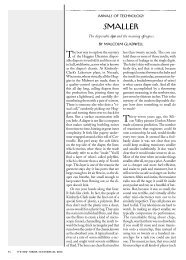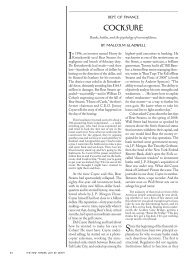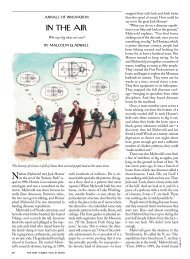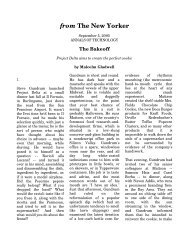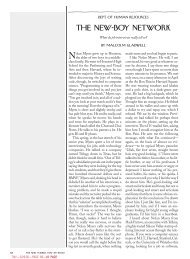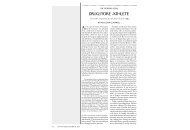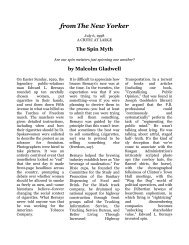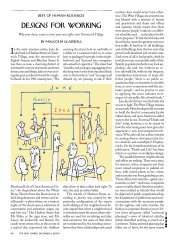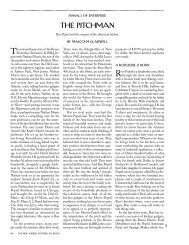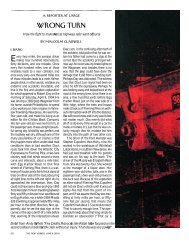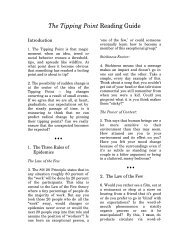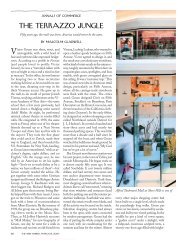The Young Garmentos - Malcolm Gladwell
The Young Garmentos - Malcolm Gladwell
The Young Garmentos - Malcolm Gladwell
Create successful ePaper yourself
Turn your PDF publications into a flip-book with our unique Google optimized e-Paper software.
70 THE NEW YORKER, APRIL 24 & MAY 1, 2000<br />
Dov Charney started his T-shirt<br />
business, American Apparel, on<br />
the corner of Santa Fe Avenue and<br />
the 10 Freeway, a mile or so from<br />
downtown Los Angeles. Actually, his<br />
factory was built directly underneath<br />
the eastbound and westbound lanes,<br />
and the roof over the room where the<br />
cutters and sewers work was basically<br />
the freeway itself, so that the clicking<br />
and clacking of sewing machines mixed<br />
with the rumble of tractor trailers. It<br />
was not, as Dov was the first to admit,<br />
an ideal location, with the possible exception<br />
that it was just two blocks from<br />
the Playpen, the neighborhood strip<br />
bar, which made it awfully convenient<br />
whenever he decided to conduct a fitting.“Big<br />
companies tend to hire fitting<br />
models at a hundred bucks an hour,”<br />
Dov explained recently as he headed<br />
over to the Playpen to test some of his<br />
new T-shirts. “But they only give you<br />
one look. At a strip bar, you get a crosssection<br />
of chicks. You’ve got big chicks,<br />
little chicks, big-assed chicks, littleassed<br />
chicks, chicks with big tits, and<br />
chicks with little tits. You couldn’t ask<br />
for a better place to fit a shirt.”<br />
He had three of his staff with him,<br />
and half a dozen samples of his breakthrough<br />
Classic Girl line of “baby T”s,<br />
in this case shirts with ribbed raglan<br />
three-quarter sleeves in lilac and pink.<br />
He walked quickly, leaning forward<br />
slightly, as if to improve his aerodynamics.<br />
Dov is thirty-one years old and<br />
has thick black hair and blue-tinted<br />
aviator glasses, and tends to dress in<br />
khakis and knit vintage shirts, with<br />
one of his own T-shirts as an undergarment.<br />
In front of the Playpen, Dov<br />
waved to the owner, a middle-aged<br />
Lebanese man in a red guayabera, and<br />
ushered his group into the gloom of<br />
the bar. At this hour—two o’clock in<br />
the afternoon—the Playpen was almost<br />
empty; just one girl gyrated for a customer,<br />
to what sounded like the music<br />
LETTER FROM LOS ANGELES<br />
THE YOUNG GARMENTOS<br />
<strong>The</strong> T-shirt trade becomes a calling.<br />
BY MALCOLM GLADWELL<br />
from “Ali Baba and the Forty Thieves.”<br />
<strong>The</strong> situation was ideal, because it<br />
meant the rest of the girls had time<br />
to model.<br />
<strong>The</strong> first to come over was Diana,<br />
dark-haired and buxom. She slipped<br />
out of a yellow mesh dress and pulled<br />
on one of Dov’s baby T’s. Dov examined<br />
her critically. He was concerned<br />
about the collar. <strong>The</strong> Classic Girl is<br />
supposed to have a snug fit, with none<br />
of the torquing and bowing that plague<br />
lesser shirts. But the prototype was<br />
bunching around the neck. Dov gestured<br />
to one of his colleagues. “Olin,<br />
look what’s going on here. I think<br />
there’s too much binding going into<br />
the machine.” Diana turned around,<br />
and wiggled her behind playfully. Dov<br />
pulled the T-shirt tight.“I think it could<br />
be a little longer here,” he said, pursing<br />
his lips. Baby T’s, in their earlier incarnation,<br />
were short, in some cases above<br />
the belly button—something that Dov<br />
considers a mistake. <strong>The</strong> music was<br />
now deafening, and over a loudspeaker<br />
a “lap-dance promo” was being announced.<br />
Dov, oblivious, turned his attention<br />
to Mandy, a svelte, long-legged<br />
blonde in a black bikini. On her, Dov<br />
observed, the shirt did not fit so “emphatically”<br />
around the chest as it had on<br />
Diana. Dov looked Mandy up and<br />
down, tugging and pulling to get the<br />
shirt just right. “When you’re doing a<br />
fitting, often the more oddly shaped<br />
girl will tell you a lot more,” he said. By<br />
now, a crowd of strippers was gathering<br />
around him, presumably attracted<br />
by the novelty of being asked by a<br />
customer to put clothes on. But Dov<br />
had seen all he needed to. His life’s<br />
great cause—which is to produce the<br />
world’s finest T-shirt for between three<br />
and four dollars wholesale—had advanced<br />
another step. “What did I learn<br />
today?” he asked, as he strode out the<br />
door.“I learned that my sleeves are perfect.<br />
But I see a quality problem with
SABA Dov Charney (second from left), with Rick Klotz, learning more about the perfect baby T. Photograph by Martin Schoeller.<br />
the collar.” He thought for a moment.<br />
“And I definitely have to add an inch to<br />
the garment.”<br />
<strong>The</strong>re is a town in upstate New York,<br />
just north and west of Albany,<br />
called Gloversville, so named because in<br />
the late nineteenth century and the early<br />
part of the twentieth century ninety-five<br />
per cent of the fine gloves sold in the<br />
United States were manufactured there.<br />
At one time, there were a hundred and<br />
sixteen glove factories in the town, employing<br />
twelve thousand people and<br />
turning out fifteen million dollars’ worth<br />
of gloves a year. New glove start-ups<br />
appeared all the time, whenever some<br />
glove entrepreneur—some ambitious<br />
handschumacher—had a better idea about<br />
how to make a glove. A trade journal,<br />
Glovers Review, covered the industry’s<br />
every step. Local firms—such as Jacob<br />
Adler & Co. and Louis Meyers & Sons<br />
and Elite Glove Co.—became nationally<br />
known brands. When the pogroms<br />
of Eastern Europe intensified, in the<br />
eighteen-eighties, the Jewish glove cutters<br />
of Warsaw—the finest leather artisans<br />
of nineteenth-century Europe—<br />
moved en masse to Gloversville, because<br />
Gloversville was where you went in<br />
those days if you cared about gloves.<br />
It’s hard to imagine anyone caring<br />
so deeply about gloves, and had we visited<br />
Gloversville in its prime most of<br />
us would have found it a narrow and<br />
provincial place. But if you truly know<br />
gloves and think about them and dream<br />
about them and, more important, if you<br />
are surrounded every day by a community<br />
of people who know and think and<br />
dream about gloves, a glove becomes<br />
more than a glove. In Gloversville, there<br />
was an elaborate social hierarchy. <strong>The</strong><br />
handschumacher considered himself so-<br />
THE NEW YORKER, APRIL 24 & MAY 1, 2000 71
72 THE NEW YORKER, APRIL 24 & MAY 1, 2000<br />
cially and intellectually superior to the<br />
schuster and the schneider—the shoemaker<br />
and the tailor.To cover the hands,<br />
after all, was the highest calling. (As the<br />
glover’s joke goes,“Did you ever see anyone<br />
talk using his boots?”) Within the<br />
glove world, in turn, the “makers”—the<br />
silkers, the closers, and the fourchetters,<br />
who sewed the gloves—were inferior to<br />
the “cutters,” who first confronted the<br />
hide, and who advertised their status by<br />
going to work wearing white shirts and<br />
collars, bow ties or cravats, tigereye cufflinks,<br />
and carefully pressed suits. A<br />
skilled cutter could glance at a glove and<br />
see in it the answers to a hundred questions.<br />
Is the leather mocha, the most pliable<br />
of all skins, taken from the hide of<br />
long-black-haired Arabian sheep? Or is<br />
it South African capeskin, the easiest to<br />
handle? Is it kid from Spain, peccary<br />
from the wild pigs of Brazil and Mexico,<br />
chamois from Europe, or cabretta, from<br />
a Brazilian hairy sheep? Is the finish<br />
“grained”—showing the outside of the<br />
hide—or “velvet,” meaning that the<br />
leather has been buffed? Is it sewn in a<br />
full-piqué stitch or a half-piqué,an osann<br />
or an overseam? Do the color and texture<br />
of the fourchette—the strip of leather<br />
that forms the sides of the fingers—<br />
match the adjoining leather? <strong>The</strong> lesson<br />
of Gloversville is that behind every ordinary<br />
object is a group of people to whom<br />
that object is anything but ordinary.<br />
Dov Charney lives in his own,modern-<br />
“If I were money, you’d listen to me.”<br />
day version of Gloversville. He is part of<br />
a world that cares about T-shirts every<br />
bit as much as the handschumachers cared<br />
about peccary and cabretta. It is impossible<br />
to talk about Dov, for example,<br />
without talking about his best friend,<br />
Rick Klotz, who runs a clothing company<br />
named Fresh Jive, about a mile and<br />
a half from Dov’s factory. Rick, who is<br />
thirty-two, designs short-sleeve shirts<br />
and baggy pants and pullovers and<br />
vests and printed T-shirts with exquisite<br />
graphics (featuring everything from an<br />
obscure typographical scheme to the<br />
Black Panthers). In the eighties, Rick<br />
was a punker, at least until everyone else<br />
got short hair, at which point he grew<br />
his hair long. Later, in his Ted Nugentand-TransAm<br />
phase, he had, he says,<br />
a “big, filthy mustache, like Cheech.”<br />
Now he is perfectly bald, and drives a<br />
black custom-made late-model Cadillac<br />
Fleetwood Limited, with a VCR in the<br />
back, and, because he sits very low in<br />
the seat, and bobs up and down to very<br />
loud hip-hop as he drives, the effect,<br />
from the street, is slightly comic, like<br />
that of a Ping-Pong ball in choppy water.<br />
When Dov first came to Los Angeles,<br />
a few years ago, he crashed at Rick’s<br />
apartment in Hollywood, and the two<br />
grew so close that Rick believes he and<br />
Dov were “separated at birth.”<br />
“If it wasn’t for Rick, I wouldn’t have<br />
been able to make it,” Dov says. “I slept<br />
on his couch. I checked in for a few days,
“Where are you going with this, Wingate?”<br />
stayed for a year.” This was after an initial<br />
foray that Dov had made into the<br />
T-shirt business, in South Carolina in<br />
the early nineties, failed.“When he lived<br />
with me, he was on the brink,” Rick<br />
added. “Every day was the same. Go to<br />
sleep at two with the phone.<strong>The</strong>n wake<br />
up at six to call back East. One time,<br />
he was just crying and losing it. It was<br />
just so heavy. I was, like, ‘Dude, what<br />
are you doing?’ ”<br />
What do Rick and Dov have in common?<br />
It isn’t a matter of personality. Dov<br />
says that sometimes when he’s out with<br />
Rick he’ll spot one of Rick’s T-shirts,<br />
and he’ll shout, “<strong>The</strong>re’s one of your<br />
T-shirts!” Rick will look down and away,<br />
embarrassed, because he’s so acutely<br />
aware of how uncool that sounds. Dov<br />
couldn’t care less. When he spots his<br />
own work, he can hardly contain himself.<br />
“I always say, ‘Hey’ ”—Dov put on<br />
the accent of his native Montreal—<br />
“ ‘where did you get that shirt?’ Like, if<br />
I’m on the subway in New York City. I<br />
say,‘You want some more?’ I take my bag<br />
and give them out for free. I’m excited<br />
about it. I could be watching TV at night,<br />
or I could be watching a porno, and,<br />
boom, there is my T-shirt. I’ve made<br />
millions of them. I always know it!”<br />
What the two of them share is a certain<br />
sensibility. Rick grew up in the Valley<br />
and Dov grew up in Montreal, but it’s<br />
as if they were born and raised in the<br />
same small town, where the T-shirt was<br />
something that you lived and died for.<br />
At dinner one recent night in L.A., Rick<br />
talked about how he met Dov, several<br />
• •<br />
74 THE NEW YORKER, APRIL 24 & MAY 1, 2000<br />
years ago, at a big trade show in Las<br />
Vegas. “I’m at this party sitting out on<br />
the balcony. I see this guy dancing and<br />
he’s—what’s the word?” And here Rick<br />
did a kind of spastic gyration in his seat.<br />
“Imbecilic. He didn’t care what anybody<br />
thought. And he catches me looking and<br />
goes like this.” Rick made two pistols<br />
out of his fingers, and fired one hand<br />
after another. “I was, like, in love.”<br />
Dov seemed touched. “You know, I<br />
knew of Rick long before I ever met<br />
him. His T-shirt graphics are some of<br />
the most respected T-shirt graphics in<br />
the world. I swear to God.”<br />
But Rick was being modest again.<br />
“No, they’re not.”<br />
“If you mention Fresh Jive in most<br />
industrialized countries to people that<br />
know what good graphics are on T-shirts,<br />
they’re, like . . . ” Dov made an appreciative<br />
noise. “I swear, it’s like a connoisseur’s<br />
wine.”<br />
“Maybe at one time,”Rick murmured.<br />
“He is an artist!” Dov went on, his<br />
voice rising. “His canvas is fabric!”<br />
On the day that he made his foray to<br />
the Playpen, Dov met with a fortyish<br />
man named Jhean. In the garmentmanufacturing<br />
business in Los Angeles,<br />
the up-and-coming entrepreneurs are<br />
Persian and Korean. (Dov has a partner<br />
who is Korean.) <strong>The</strong> occasional throwback,<br />
like Dov, is Jewish. Jhean, however,<br />
is Haitian. He used to work in government,<br />
but now he is in the garment business,<br />
a career change of which Dov<br />
heartily approved. Jhean was wearing<br />
tight black pants, a red silk shirt open to<br />
mid-chest, and a gold chain. Dov put his<br />
arm around him affectionately. “Jhean<br />
is a crazy man,” he announced, to no<br />
one in particular. “He was going to be<br />
one of my partners. We were going to<br />
get this whole Montreal Jewish-Korean-<br />
Haitian thing going.” Jhean turned away,<br />
and Dov lowered his voice to a whisper.<br />
“Jhean has it in his blood, you know,” he<br />
said, meaning a feel for T-shirts.<br />
Dov led Jhean outside, and they sat<br />
on a bench, the sun peeking through<br />
at them between the off-ramp and the<br />
freeway lanes. Jhean handed Dov a men’s<br />
Fruit of the Loom undershirt, size medium.<br />
It was the reason for Jhean’s visit.<br />
“Who can do this for me?” he asked.<br />
Dov took the shirt and unfolded it<br />
slowly. He held it up in front of his eyes,<br />
as a mother might hold a baby, and let<br />
out a soft whistle. “This is an unbelievable<br />
garment,” he said. “Nobody has the<br />
machines to make it, except for two parties<br />
that I’m aware of. Fruit of the Loom.<br />
And Hanes. <strong>The</strong> shirt is a two-by-one<br />
rib. <strong>The</strong>y’ve taken out one or two of the<br />
needles. It’s a coarse yarn. And it’s tubular,<br />
so there is no waste.This is one of the<br />
most efficient garments in the world. It<br />
comes off the tube like a sock.”<br />
Some T-shirts have two seams down<br />
each side: they are made with “open<br />
width” fabric, by sewing together the<br />
front and the back of the T-shirt. This<br />
T-shirt had no seams. It was cut from<br />
cotton fabric that had been knitted into<br />
a T-shirt-size tube, which is a trickier<br />
procedure but means less wasted fabric,<br />
lower sewing costs, and less of the twisting<br />
that can distort a garment.<br />
Dov began to run his fingers along<br />
the bottom of the shirt, which had been<br />
not hemmed but overlocked—with a<br />
stitch—to save even more fabric. “This<br />
costs, with the right equipment, maybe a<br />
dollar. My cost is a dollar-thirty, a dollarfifty.<br />
<strong>The</strong> finest stuff is two-fifty, twosixty.<br />
If you can make this shirt, you can<br />
make millions. But you can’t make this<br />
shirt. Hanes actually does this even better<br />
than Fruit of the Loom.<strong>The</strong>y’ve got<br />
this dialled down.” Jhean wondered if<br />
he could side-seam it, but Dov just<br />
shook his head.“If you side-seam it, you<br />
lose the whole energy.”<br />
You could tell that Dov was speaking<br />
as much to himself as to Jhean. He was<br />
saying that he couldn’t reproduce a master-
piece like that undershirt, either. But<br />
there was no defeat in his voice, because<br />
he knew enough about T-shirts to realize<br />
that there is more than one way to make<br />
a perfect garment. Dov likes to point out<br />
that the average American owns twentyfive<br />
T-shirts—twenty-five!—and, even if<br />
you reckon, as he does, that of those only<br />
between four and seven are in regular rotation,<br />
that’s still an enormous market.<br />
<strong>The</strong> garment in question was either<br />
eighteen- or twenty-singles yarn, which<br />
is standard for T-shirts. But what if a<br />
T-shirt maker were to use thirty-singles<br />
yarn, knitted on a fine-gauge machine,<br />
which produces a thinner, more “fashionforward”<br />
fabric? <strong>The</strong> Fruit of the Loom<br />
piece was open-end cotton, and openend<br />
is coarse. Dov likes “ring-spun<br />
combed” yarn, which is much softer, and<br />
costs an extra eighty cents a pound. Softness<br />
also comes from the way the fabric<br />
is processed before cutting, and Dov is<br />
a stickler for that kind of detail. “I have<br />
a lot of secret ingredients,” he says. “Just<br />
like K.F.C. <strong>The</strong>re is the amount of yarn<br />
in one revolution, which determines the<br />
tightness.<strong>The</strong>re’s the spacing of the needle.<br />
<strong>The</strong>n there’s the finishing. What<br />
kind of chemicals are you using in the<br />
finishing? We think this through.We’ve<br />
developed a neurosis about this.” In his<br />
teens, Dov hooked up with a friend who<br />
was selling printed T’s outside the Montreal<br />
Forum, and Dov’s contribution was<br />
to provide American Hanes instead of<br />
the Canadian poly-cotton-blend Penmans.<strong>The</strong><br />
Hanes, Dov says, was “creamier,”<br />
and he contended that the Canadian<br />
T-shirt consumer deserved that extra<br />
creaminess. When he’s inspecting rolls<br />
of fabric, Dov will sometimes break into<br />
the plastic package wrap and run his<br />
hand over the cotton, palm flat, and if<br />
you look behind his tinted aviators you’ll<br />
see that his eyes have closed slightly.<br />
Once, he held two white swatches up to<br />
the light, in order to demonstrate how<br />
one had “erections”—little fibres that<br />
stood up straight on the fabric—and<br />
the other did not, and then he ran his<br />
hand ever so slightly across the surface<br />
of the swatch he liked, letting the fibres<br />
tickle his palm.“I’m particular,” Dov<br />
explained. “Like in my underwear. I’m<br />
very committed to Hanes thirty-two. I’ve<br />
been wearing it for twelve years. I sleep<br />
in it. And if Hanes makes any adjustments<br />
I’m picking it up. I watch. <strong>The</strong>y<br />
76 THE NEW YORKER, APRIL 24 & MAY 1, 2000<br />
change their labels, they use different<br />
countries to make their shit, I know.”<br />
Dov was back inside his factory now,<br />
going from the room where all the<br />
sewers sit, stitching up T-shirts, to a passageway<br />
lined with big rolls of fabric.<br />
<strong>The</strong> fact that Jhean’s Fruit of the Loom<br />
undershirt was of rib fabric launched<br />
him on one of his favorite topics, which<br />
was the fabric he personally helped rediscover—baby<br />
rib. Baby rib is rib in<br />
which the ridges are so close together<br />
and the cotton is so fine that it looks like<br />
standard T-shirt jersey, and Dov’s breakthrough<br />
was to realize that because of<br />
the way it stretches and supports and<br />
feels it was perfect for girls. “See this,<br />
that’s conventional rib.” He pulled on a<br />
piece of white fabric, exposing wide<br />
ridges of cotton. “It’s knitted on larger<br />
machines. And it’s a larger, bulkier yarn.<br />
It’s poor-quality cotton. But girls want<br />
softness. So, rather than take the cheap<br />
road, I’ve taken the higher road.” Dov’s<br />
baby rib uses finer cotton and tighter<br />
stitching, and the fit is tighter across<br />
the chest and shoulders, the way he<br />
believes a T-shirt ought to look. “<strong>The</strong>re<br />
were a few influences,” he said, reflecting<br />
on the creative process that brought<br />
him to baby rib. “I’m not sure which<br />
girlfriend, but we can name some.”<br />
He ticked them off on his fingers.<br />
“<strong>The</strong>re’s Marcella, from Argentina. I<br />
met her in South Beach. She wore these<br />
little tops made in South America.<br />
And they were finer than the tops that<br />
girls were wearing in the States. I got<br />
such a boner looking at her in that<br />
T-shirt that I thought, This is doing<br />
something for me. We’ve got to explore<br />
this opportunity.This was four, five years<br />
ago. O.K., I broke up with her, and I<br />
started going out with this stripper, Julie,<br />
from South Carolina. She had a<br />
gorgeous body. She was all-American.<br />
And, you know, Julie looked so great<br />
in those little T-shirts. She put one on<br />
and it meant something.”<br />
Dov pulled out a single typewritten<br />
page, a draft of a “mission statement” he<br />
was preparing for the industry.This was<br />
for a new line of Standard American<br />
T-shirts he wanted to start making—<br />
thirty-singles, ring-spun, tubular shirts<br />
knit on custom-made Asian equpiment.<br />
“Dear Client,” it began:<br />
During the last ten years major T-shirt<br />
makers such as Hanes and Fruit of the Loom<br />
have focused on being “heavier” and generously<br />
cut. Innovation and style have been put<br />
aside, and there has been a perpetual price<br />
war during the last four years. <strong>The</strong> issues are<br />
who can be cheaper, bigger or heavier. . . .<br />
Concerns about fit or issues of softness or<br />
stretch have been the last priority and have<br />
been barely considered. In order to create<br />
leadership we have reconstructed the T-shirt<br />
and have made a deviation from the traditional<br />
“Beefy-T” styled garment. We have redone<br />
the typical pattern. It is slightly more fitted—especially<br />
in the sleeve and armhole<br />
opening. . . . Yes the fabric is lighter, and we<br />
think that is a positive aspect of the garment.<br />
<strong>The</strong> garment has a stretch that is reminiscent<br />
of T-shirts from decades ago.<br />
Dov was peering over my shoulder as<br />
I read. “We’re going to kick everybody’s<br />
ass,” he announced. “<strong>The</strong> finest T-shirts<br />
are six dollars a piece wholesale. <strong>The</strong><br />
shittiest shirts are like two dollars. We’re<br />
going to come in at three and have the<br />
right stuff. I’m making the perfect fit. I’m<br />
going to manufacture this like gasoline.”<br />
If you ask Dov why he’s going to<br />
these lengths, he’ll tell you that it matters<br />
to him that Americans can buy an affordable<br />
and high-quality T-shirt.That’s<br />
an admirable notion, but, of course,<br />
most of us don’t really know what constitutes<br />
a high-quality T-shirt: we don’t<br />
run our hands over a swatch of cotton<br />
and let the little fibres tickle our palm,<br />
or ruminate on the difference between<br />
side-seaming and tubularity. For that<br />
matter, few people who bought dress<br />
gloves in 1900 knew the difference between<br />
a full-piqué or a half-piqué stitch,<br />
between high-grade or merely mediumgrade<br />
peccary. Producers, the economics<br />
textbooks tell us, are disciplined by the<br />
scrutiny of the marketplace. Yet what of<br />
commonplace articles such as T-shirts<br />
and gloves, about which most customers<br />
don’t know enough or care enough to<br />
make fine discriminations? Discipline<br />
really comes not from customers but<br />
from other producers. And here again
78 THE NEW YORKER, APRIL 24 & MAY 1, 2000<br />
the economics textbooks steer us wrong,<br />
because they place too much emphasis<br />
on the role of formal competitors, the<br />
Gap or Hanes or the other big glovemaker<br />
in your niche.To be sure, Dov can<br />
occasionally be inspired by a truly exceptional<br />
garment like, say, a two-byone<br />
ribbed undershirt from Fruit of the<br />
Loom. But in Gloversville the critical<br />
person is not so much the distant rival<br />
as the neighbor who is also a contractor,<br />
or the guy at the bar downtown who<br />
used to be in the business, or the friend<br />
at synagogue who is also an expert glovemaker—all<br />
of whom can look at your<br />
work with a practiced eye and shame<br />
you if it isn’t right. Dov is motivated<br />
to produce a high-quality T-shirt at<br />
three dollars because that would mean<br />
something to Jhean and to Olin and,<br />
most of all, to Rick, whose T-shirt<br />
graphics are respected around the world.<br />
In Gloversville, the market is not an<br />
economic mechanism but—and this is<br />
the real power of a place like that—a<br />
social one.<br />
“Everybody got so technically obsessed<br />
with reduced shrinkage,” Dov<br />
went on, and by “everyone” he meant a<br />
group of people you could count on<br />
the fingers of one hand. “That was a<br />
big mistake for the industry because<br />
they took away the natural stretch property<br />
of a lot of the jersey. If you look at<br />
vintage shirts, they had a lot of stretch.<br />
Today, they don’t. <strong>The</strong>y are like these<br />
print boards.<strong>The</strong>y are practically woven<br />
in comparison. I say fuck the shrinkage.<br />
I have a theory on width shrinkage on<br />
rib: I don’t care. In fact, you put it on, it<br />
will come back.” He was pacing back and<br />
forth and talking even more rapidly than<br />
usual.“I’m concerned about linear shrinkage.<br />
But, if it doesn’t have any width<br />
shrinkage at all, I become concerned,<br />
too. I have a fabric I’m working on with<br />
a T-shirt engineer. It keeps having zero<br />
width shrinkage. That’s not desirable!”<br />
Dov stopped. He had spotted something<br />
out of the corner of his eye. It was<br />
one of his workers, a young man with<br />
a mustache and a goatee and slickedback<br />
hair. He was wearing a black custom<br />
T, with two white stripes down the<br />
arms. Dov started walking toward him.<br />
“Oh, my God. You want to see something?”<br />
He reached out and flipped up<br />
the tag at the back of the cutter’s shirt.<br />
“It’s a Fresh Jive piece. I made it for Rick
five years ago. Somehow this shirt just<br />
trickled back here.”<strong>The</strong> sweet serendipity<br />
of it all brought a smile to his face.<br />
While Dov was perfecting his baby<br />
T’s, Rick was holding a fashion<br />
shoot for his elegant new women’s-wear<br />
line, Fresh Jive Domestics, which had<br />
been conceived by a young designer<br />
named Jessica. <strong>The</strong> shoot was at Rick’s<br />
friend Deidre’s house, a right-angled,<br />
white-stuccoed, shag-rugged modernist<br />
masterpiece under the Hollywood sign.<br />
Deidre rents it from the drummer of the<br />
seventies supergroup Bread. Madonna’s<br />
old house is several hundred yards to the<br />
west of Deidre’s place, and Aldous Huxley<br />
used to live a few hundred yards in the<br />
other direction, with the result that her<br />
block functions as a kind of architectural<br />
enactment of postwar Los Angeles intellectual<br />
life. For Rick’s purposes, though,<br />
the house’s main points of attraction<br />
were its fabulous details, like the little<br />
white Star Trek seats around the kitchen<br />
counter and the white baby grand in the<br />
window with the autographed Hugh<br />
Hefner photo and the feisty brownhaired<br />
spitz-collie named Sage barricaded<br />
in the kitchen. Rick had a box of<br />
disposable cameras, and as he shot the<br />
models other people joined in with the<br />
disposables, so that in the end Rick<br />
would be able to combine both sets of<br />
pictures in a brag book. It made for a<br />
slightly chaotic atmosphere—particularly<br />
since there were at least seven highly<br />
active cell phones in the room, each with<br />
a different ring, competing with the hiphop<br />
on the stereo—and in the midst of it<br />
all Rick walked over to the baby grand<br />
and, with a mischievous look on his face,<br />
played the opening chords of Beethoven’s<br />
“Pathétique” sonata.<br />
Rick was talking about his plans to<br />
open a Fresh Jive store in Los Angeles.<br />
But he kept saying that it couldn’t be on<br />
Melrose Avenue, where all the streetwear<br />
stores are. “Maybe that would be<br />
good for sales,” he said. <strong>The</strong>n he shook<br />
his head. “No way.”<br />
Deidre, who was lounging next to the<br />
baby grand, started laughing.“You know<br />
what, Rick?” she said. “I think it’s all<br />
about a Fresh Jive store without any<br />
Fresh Jive stuff in it.”<br />
It was a joke, but in some way not a<br />
joke, because that’s the sort of thing that<br />
Rick might actually do. He’s terrified by<br />
THE NEW YORKER, APRIL 24 & MAY 1, 2000 81
the conventional. At dinner the previous<br />
evening, for example, he and Dov had<br />
talked about a particular piece—the<br />
sports-style V-necked raglan custom T<br />
with stripes that Dov had spotted on the<br />
cutter. Rick introduced it years ago and<br />
then stopped making it when everyone<br />
else started making it, too.<br />
“One of our biggest retailers takes me<br />
into this room last year,” Rick explained.<br />
“It’s full of custom T-shirts. He said,<br />
‘You started this, and everybody else<br />
took advantage of it. But you didn’t go<br />
with it.’ He was pissed off at me.”<br />
<strong>The</strong> businessman in Rick knew that he<br />
shouldn’t have given up on the shirt so<br />
quickly, that he could have made a lot<br />
more money had he stayed and exploited<br />
the custom-T market. But he couldn’t do<br />
that, because if he had been in that room<br />
with all the other custom T’s he risked<br />
being known in his world as the guy who<br />
started the custom-T trend and then ran<br />
out of new ideas. Retail chains like J.C.<br />
Penney and Millers Outpost sometimes<br />
come to Rick and ask if they can carry<br />
Fresh Jive, or ask if he will sell them a big<br />
run of a popular piece, and he usually<br />
says no.He will allow his clothes to appear<br />
only in certain street-wear boutiques.<br />
His ambition is to grow three times as<br />
big as he is now—to maybe a thirty-<br />
million-dollar company—but no larger.<br />
This is the sensibility of the artisan,<br />
and it isn’t supposed to play much of a<br />
role anymore. We live in the age of the<br />
entrepreneur, who responds rationally to<br />
global pressures and customer demands<br />
in order to maximize profit. To the extent<br />
that we still talk of Gloversville—<br />
and the glove-making business there has<br />
long since faded away—we talk of it as a<br />
place that people need to leave behind.<br />
<strong>The</strong>re was Lucius N. Littauer, for example,<br />
who, having made his fortune with<br />
Littauer Brothers Glove Co., in downtown<br />
Gloversville, went on to Congress,<br />
became a confidant of Presidents Mc-<br />
Kinley and Roosevelt, and then put up<br />
the money for what is now the Kennedy<br />
School of Government, at Harvard<br />
University.<strong>The</strong>re was Samuel Goldwyn,<br />
the motion-picture magnate, who began<br />
his career as a cutter with Gloversville’s<br />
Elite Glove Co. In 1912, he jumped into<br />
the movie business. He went to Hollywood.<br />
He rode horses and learned to<br />
play tennis and croquet. Like so many<br />
immigrant Jews in the movie industry,<br />
he enacted through his films a very public<br />
process of assimilation. This is the<br />
oldest of American stories: the heroic<br />
young man who leaves the small town to<br />
play on the big stage—who wants to be<br />
an entrepreneur, not an artisan. But the<br />
truth is that we always get the story<br />
wrong. It isn’t that Littauer and Goldwyn<br />
left Gloversville to find the real culture,<br />
because the real culture comes from<br />
Gloversville, too; places like Washington<br />
and Hollywood persist and renew themselves<br />
only because Littauers and Goldwyns<br />
arrive from time to time, bringing<br />
with them a little piece of the real thing.<br />
“<strong>The</strong> one paranoia Rick has is that,<br />
God forbid, he makes something that<br />
another company has,” Dov said, at dinner<br />
with Rick that night.<br />
Rick nodded. “In my personal life.<br />
Ask Dov. Every piece of clothing I own.<br />
Nobody else can have it.”<br />
Rick was wearing a pair of jeans and<br />
a plain white T-shirt, but if you looked<br />
closely you noticed that it wasn’t just any<br />
jeans-and-T-shirt ensemble. <strong>The</strong> pants<br />
were an unusual denim chino, from<br />
Rick’s Beggars Banquet collection. And<br />
the shirt?<br />
“That is a very well-thought-out<br />
item,” Dov said, gesturing toward Rick.<br />
“It’s a purple-label BVD. It’s no longer<br />
available. Size medium. Of all the shirts<br />
I’ve studied, this one has a phenomenal<br />
fit.” He reached across the table and ran<br />
his fingers around the lower edge of the<br />
sleeve. Dov is a believer in a T-shirt that<br />
is snug on the biceps. “It’s not the greatest<br />
fabric. But it shrinks perfectly. I actually<br />
gave him that shirt. I came back<br />
from one of my customers in New York<br />
City, on Grand Street, that happens to<br />
resell that particular garment.”<br />
It’s all of a piece,in the end:the purplelabel<br />
BVD, the custom-T that he designed<br />
but now won’t touch. If in Dov’s<br />
world the true competitive pressures are<br />
not economic but social, Rick’s version of<br />
Gloversville is driven not by the marketplace<br />
but by personality—the particular,<br />
restless truculence of the sort of person<br />
who will give up almost anything and go<br />
to any lengths not to be like anyone else.<br />
“We’re doing this line of casual shoes,”<br />
Rick said, during a rare lull in one of<br />
Dov’s T-shirt soliloquies. “One is the<br />
Crip Slip. It’s that corduroy slipper that<br />
the gang kids would always wear. <strong>The</strong><br />
other is the Wino, which is that really<br />
cheap canvas slipper that you can buy<br />
at K mart for seven dollars and that the<br />
winos wear when they’re, like, really<br />
hung over.” His big new idea, Rick explained,<br />
was to bring out a line of com-
84 THE NEW YORKER, APRIL 24 & MAY 1, 2000<br />
plementary twelve-inch dolls in those<br />
characters. “We could have a guy with<br />
baggy pants and a pushcart,” he went<br />
on. “You know, you pull down his pants<br />
and there’s skid marks. And we have a<br />
full gangster for the Crip Slip.”<br />
Rick was so excited about the idea<br />
that he was still talking about it the next<br />
day at work. He was with a Fresh Jive<br />
designer named Jupiter—a skateboarder<br />
from Las Vegas of German, Welsh,<br />
Irish, French, Chinese, and Spanish<br />
extraction—and a guy named Matt,<br />
who wore on his chest a gold-plated,<br />
diamond-encrusted Star of David the<br />
size of a Peppermint Pattie. “<strong>The</strong> idea<br />
is that the doll would pump the shoe,<br />
and the shoe would pump the doll,”<br />
Rick said. “<strong>The</strong> doll for the Crip Slip<br />
would be totally gangster. <strong>The</strong> handkerchief.<br />
<strong>The</strong> plaid shirt or the wife<br />
beater. A forty in his hand. Flashing<br />
signs.Wouldn’t that be crazy?” And then<br />
Rick caught himself.“Omigod.<strong>The</strong> doll<br />
for the Crip Slip will have interchangeable<br />
hands, with different gang signs!”<br />
Matt looked awestruck: “Ohhh,<br />
that’ll be sick!”<br />
“Wooooow.” Jupiter dragged the<br />
word out, and shook his head slowly.<br />
“That’s crazy!”<br />
Afew days later, Dov drove down to<br />
San Diego for Action Sports Retail,<br />
a big trade show in the street-wear<br />
world. Dov makes the rounds of A.S.R.<br />
twice a year, walking up and down<br />
through the cavernous conference center,<br />
stopping at the booths of hundreds<br />
of T-shirt companies and persuading<br />
people to buy his shirts wholesale for<br />
their lines.This year, he was busy scouting<br />
locations for American Apparel’s<br />
new factory, and so he arrived a day late,<br />
clutching a motorized mini-scooter. To<br />
his great irritation, he wasn’t allowed to<br />
carry it in. “This is the most uncool<br />
show,” he announced, after haggling<br />
fruitlessly with the guard at the gate.<br />
But his mood lifted quickly. How<br />
could it not? This was A.S.R., and everyone<br />
was wearing T-shirts or selling<br />
T-shirts, and because this was a place<br />
where people knew their T-shirts a lot of<br />
those T-shirts were Dov’s. He started<br />
down one of the aisles. He pointed to a<br />
booth on the left.“<strong>The</strong>y use my T-shirts.”<br />
Next to that booth was another small<br />
company. “<strong>The</strong>y use my T-shirts, too.”<br />
He was wearing khakis and New Balance<br />
sneakers and one of his men’s<br />
T-shirts in baby rib (a controversial piece,<br />
because the binding on the collar was a<br />
mere half inch). On his back he had a<br />
huge orange pack full of catalogues and<br />
samples, and every time he spotted a potential<br />
customer he would pull the backpack<br />
off and rummage through it, and<br />
the contents would spill on the floor.<br />
Dov spotted a young woman walking<br />
toward him in a baby T. “That’s a<br />
competitor’s shirt. I can tell right away.<br />
<strong>The</strong> spacing of the needle.<strong>The</strong> fabric is<br />
not baby rib.” He high-fived someone in<br />
another booth. Another young woman,<br />
in another T-shirt booth, loomed up<br />
ahead. “That’s my shirt right there. In<br />
the green. I even know the stock number.”<br />
He turned to her: “You’re the girl<br />
in the olive forty-three, sixty-six sleeveless<br />
V with one-inch binding.”<br />
She laughed, but Dov was already<br />
off again, plunging back into the fray.“I<br />
always have an insecurity that I can be<br />
crushed by a bigger business,” he said.<br />
“Like, Fruit of the Loom decided to do<br />
baby T’s, and I got a little scared. But<br />
then I saw their shirt, and I laughed, because<br />
they missed it.” Do the suits over<br />
at Fruit of the Loom have the same feel<br />
for a shirt that Dov does? Were they inspired<br />
by Marcella of Argentina and<br />
Julie from South Carolina? Those guys<br />
were off somewhere in a suburban office<br />
park. <strong>The</strong>y weren’t in Gloversville.<br />
“It was horribly designed,” Dov went<br />
on. “It was thick, open-end, eighteensingles<br />
coarse rib. It’s not the luxury<br />
that I offer. See the rib on that collar?”<br />
He pulled up the binding on the<br />
T-shirt of a friend standing next to him.<br />
“Look how thick and spacey it is.That’s<br />
what they did. <strong>The</strong>y missed the point.”<br />
Somewhere a cell phone was ringing.<br />
A young woman walked past. “Hey!”<br />
Dov called out. “That’s my T-shirt!” ♦



